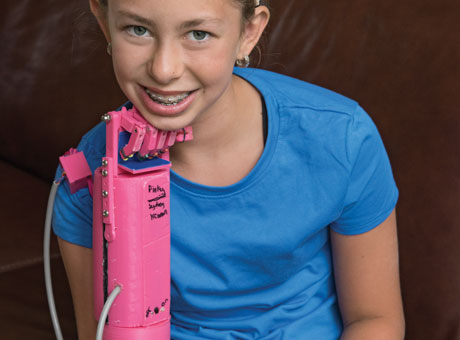



Photos by Robert Boston
Thirteen-year-old Sydney Kendall had one request for the students building her robotic prosthetic arm: Make it pink.
Kendall Gretsch, Henry Lather and Kranti Peddada, 2014 seniors studying biomedical engineering in the School of Engineering & Applied Science, accomplished that and more, with guidance from School of Medicine faculty. Using a 3-D printer, they created a robotic prosthetic arm out of bright-pink plastic. Total cost: $200, a fraction of the price of standard prosthetics, which start at $6,000.
“Currently, prosthetics are very expensive, and because kids keep growing, it is too costly for them to have the latest technology,” said Sydney’s mother, Beth Kendall.
While 3-D printers can cost about $2,500, they are capable of producing artificial limbs at a relatively low individual cost. Sydney lost her arm in a boating accident at age 6. She learned to write with her left hand, but found most tasks difficult to accomplish with her prosthetic arm.
Sydney said her new arm is easy to manipulate. By moving her shoulder, she can direct the arm to throw a ball, move a computer mouse and perform other tasks.
The students developed the robotic hand as part of an engineering design course with Joseph Klaesner, PhD, associate professor of physical therapy at the medical school. Charles A. Goldfarb, MD, and Lindley Wall, MD, orthopedic hand surgeons and associate professors of orthopaedic surgery, served as mentors.
“They brought their engineering expertise, and we shared our practical experience with prosthetics and the needs of children,” Goldfarb said.